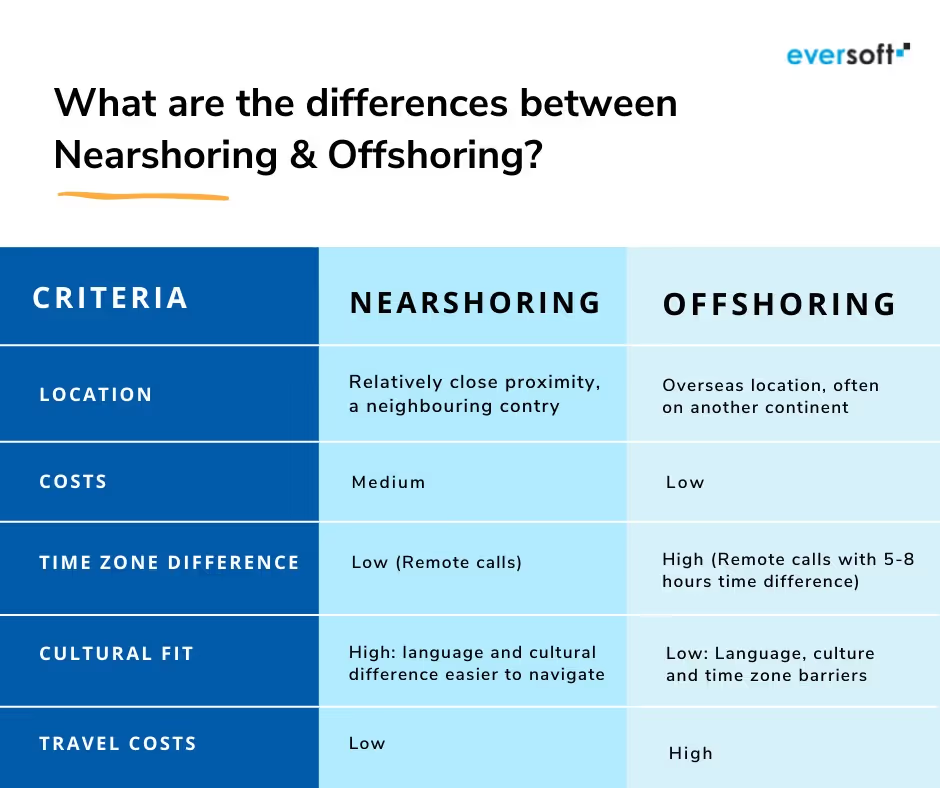Understanding the concept of nearshoring is vital as it helps businesses establish themselves for successfully and securely in the digital world. Our article will help you understand the key basics of IT nearshoring.


If you're a part of the working sector, you may already be aware of the term ‘nearshoring’. Even if you're not, let's summarize it for you. IT nearshoring involves outsourcing software development or IT services to nearby countries, rather than distant locations. Nearshoring allows companies to access skilled professionals at lower costs compared to hiring locally, while still maintaining real-time collaboration. It also reduces risks associated with longer-distance outsourcing, such as delays or communication barriers. This article aims to help readers understand the key basics of IT nearshoring and things you need to avoid when outsourcing nearshore IT consulting and software development services.

Due to many reasons, a large number of companies now opt for nearshore IT development services. By moving IT services or processes to nearby countries, companies benefit in many ways. In the below section, we explore the key basics of IT nearshoring:
One of the main advantages of nearshoring is geographical proximity. By partnering with companies in neighboring or nearby countries, businesses can save time and money on travel and logistics. In IT, having teams that share the same or similar time zones allows for real-time communication, leading to faster project execution and better issue resolution. This proximity also reduces lead times, resulting in quicker product delivery and more efficient operations.
Nearshoring provides access to a broad pool of highly skilled IT professionals. Many nearshore countries, particularly in Latin America and Eastern Europe, have invested heavily in IT education and training, creating a talented workforce. These regions often offer the same level of expertise as more distant offshore locations but with the added benefit of better alignment in work hours and cultural understanding. This ensures high-quality work while maintaining cost efficiency.
While nearshore IT development is not necessarily as inexpensive as offshoring, it offers a compelling balance between cost and quality. The reduced travel expenses, lower wage costs compared to onshoring, and minimized logistics costs all contribute to significant savings. Also, the lower communication barriers and increased collaboration efficiency that nearshoring enables can lead to faster project completion, further reducing costs in the long run.
Cultural compatibility is another critical benefit of nearshoring IT services. By working with countries that share similar cultural values, companies can avoid many of the miscommunications that often arise in offshore outsourcing. Also, many nearshore countries have a high proficiency in the same language, typically English, which ensures smoother project collaboration and clearer communication between teams.
Nearshoring offers more flexibility than traditional outsourcing models. Because nearshore partners are geographically closer, it is easier to visit them, oversee projects in person, and make necessary adjustments to the process. This flexibility also extends to risk management; having your IT operations nearshore reduces the potential impact of geopolitical instability, natural disasters, or other crises that can affect more distant locations.
Communication is critical in IT development, and nearshoring IT services excels in this aspect. With teams located in nearby countries, businesses can engage in more frequent and effective communication. This helps in aligning project goals, tracking progress, and quickly resolving issues. Clear communication also ensures that nearshore teams better understand the company's business objectives and cultural norms, leading to higher-quality outputs.
In recent years, the environmental aspect of business operations has become increasingly important. Nearshoring aligns with sustainability goals by reducing the carbon footprint associated with long-distance travel and transportation. With shorter distances between companies and their nearshore partners, there is less need for extensive international shipping or long-haul flights, which contributes to a lower environmental impact.
One important aspect of IT nearshoring is navigating the regulatory and legal requirements of the nearshore country. Every country has its own legal framework concerning data protection, intellectual property rights, and labor laws. It's crucial for businesses to ensure that their nearshore partner complies with these regulations to avoid any legal complications. Data security is particularly important for IT projects, and nearshore companies must adhere to international standards for managing sensitive information. Companies should also be aware of tax laws and any trade agreements between their country and the nearshore destination to ensure smooth financial transactions. Ensuring that contracts are clear and protecting both parties helps prevent misunderstandings later. Partnering with a nearshore company with a strong legal framework in place minimizes risk and ensures smooth project execution from start to finish.

Here, we list common things to avoid when nearshoring. By avoiding these common mistakes, businesses can improve the chances of a successful nearshoring experience, ensuring that projects are completed on time, within budget, and at a high standard of quality.
With the right partner and strategic planning, businesses can fully use the advantages of nearshoring and improve their overall performance. It is recommended to opt for a specialized agency for nearshore IT consulting and software development services as they are reliable and secure. If you are looking for such an agency, Blue Coding is the right choice for you. To learn more about us and how we can help you, contact us and book your free strategy call!
Subscribe to our blog and get the latest articles, insights, and industry updates delivered straight to your inbox